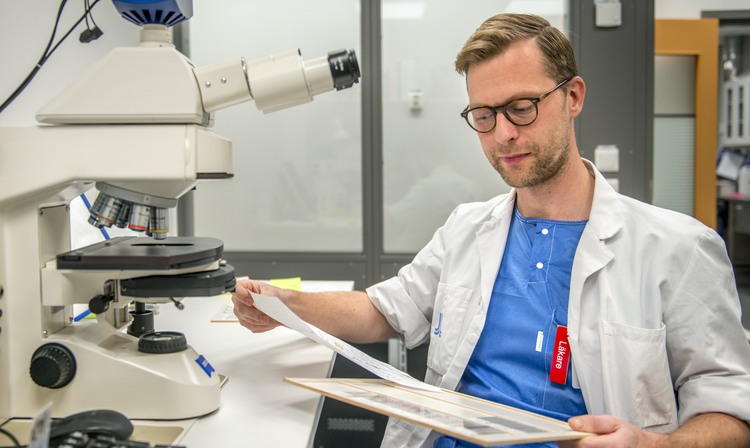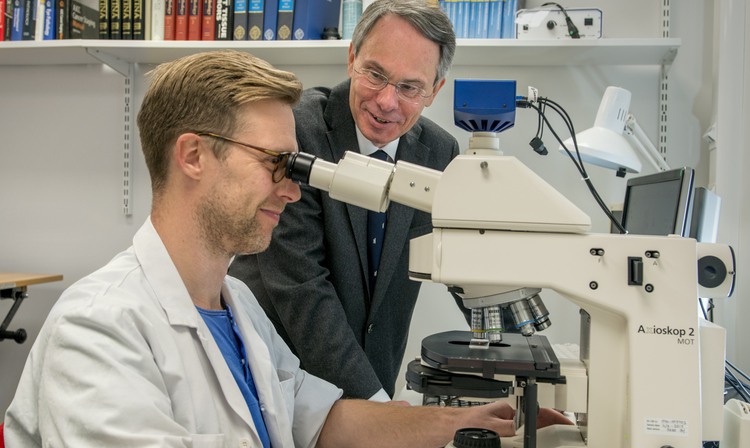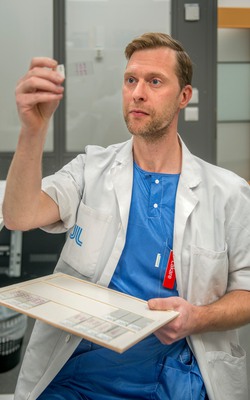When the certificate from Sweden’s National Board of Health and Welfare confirming Gustav Stålhammar’s new speciality arrived in his letterbox last autumn, it marked the completion of a five-year-long residency in pathology and the starting signal for a career as an eye pathologist.
Dr. Stålhammar has also completed an equally long residency in eye diseases and will now split his clinical duties between eye oncology and eye pathology at St. Erik Eye Hospital while also pursuing eye cancer research at Karolinska Institutet.
"It feels great. It’s been a long journey that's finally come to an end. Eye pathology is a quiet oasis in the stormy world of medicine. Here we have a small, well-oiled lab with great staff and interesting cases. We can make a real difference for patients with often aggressive diseases. There are only a handful of similar environments in the world, and it’s no exaggeration to say that we have a good chance of positioning ourselves among the very best of them," says Dr. Stålhammar.

Gustav Stålhammar is also a researcher.
Photo: Jens Sølvberg
A pathologist at St. Erik Eye Hospital analyses tissue samples from the eye or the surrounding area in a microscope, mostly in cases of suspected cancer. Pathology has a long history and is an increasingly important cornerstone of modern healthcare.
Two eye pathologists in Sweden
Some thirty years ago, Dr. Stefan Seregard also became a dual eye and pathology specialist at St. Erik Eye Hospital, where he is also a director. He acted as supervisor for Dr. Stålhammar throughout his residency.
"I was the only person in this role, but now there are two of us in Sweden, which is really great. Gustav is also from the next generation, which offers continuity and guarantees that this expertise will remain once I retire," says Dr. Seregard, who in addition to his work at St. Erik Eye Hospital is also a professor at Karolinska Institutet.

It takes five years to become a pathologist.
Photo: Jens Sølvberg
One may wonder why there are so few eye pathologists in Sweden, but according to Dr. Seregard, this is a pattern seen in many places, both nationally and internationally. Sweden has about 400 pathologists who are increasingly specialised in niche areas, such as stomach and intestinal, skin or soft tissue tumours.
"We analyse about 1,300 biopsies from all over the country and are one of Sweden’s smallest histopathology labs. Since the volume is very limited when looking at eye pathology alone, efforts need to be concentrated into a single lab for it to be viable," he says.
Founded by Dr. Erik Kock in the 1960s
Originally, the histopathology lab was known as the eye pathology laboratory. It was founded at the then Karolinska Hospital by Sweden’s first eye pathologist and eye oncologist Erik Kock at the end of the 1960s. The lab was then moved to St. Erik Eye Hospital in the 1990s. This meant that eye specimens which were difficult to diagnose no longer needed to be sent between different pathologists in Sweden.

Gustav Stålhammar.
Photo: Jens Sølvberg
Of tradition, St. Erik accepts and analyses eye specimens from both eye specialists and pathologists, and these days about a third of the biopsies are from healthcare providers in other parts of the country.
A common type of specimen analysed at the laboratory is surgically removed tissue from the eyelid. It is analysed to make the right diagnosis (such as basal-cell carcinoma or squamous cell carcinoma), to determine the tumour’s sub-group, whether all the tumour cells have been removed and the most suitable treatment, and to follow up patient progress.
The most common malignant tumours found inside the eye are malignant melanoma (in adults) and retinoblastoma (in children). Biopsies from such tumours enable the pathologist to determine how aggressive the tumour cells are and the risk for development of metastases.

New St. Erik Eye Hospital.
Photo: Jens Sølvberg
New St. Erik Eye Hospital
In September 2020, St. Erik Eye Hospital moved to new, state-of-the-art premises in Hagastaden, Solna, near Karolinska University Hospital and Karolinska Institutet. St. Erik’s new histopathology laboratory is larger than the old one and offers staff an improved and safer work environment.
At the laboratory, the tissue samples are prepared by embedding them in a special type of wax which can then be cut into extremely thin slices measuring just one thousandth of a millimetre or so. One of these slices is then mounted on a glass slide and viewed in a microscope, where it can be enlarged and analysed by an eye pathologist.
Without the expert help of the lab’s biomedical analysts Emma Lardner and Marianne Georgsson, none of this would be possible according to Dr. Seregard. Dr. Stålhammar agrees, adding:
"Together, we run a fantastic lab – and things are only going to get better! I’d like to thank everyone who’s helped me on this journey, especially Stefan Seregard, who’s a great role model. I will now join him in the small international club of eye pathologists."
Text: Helena Mayer